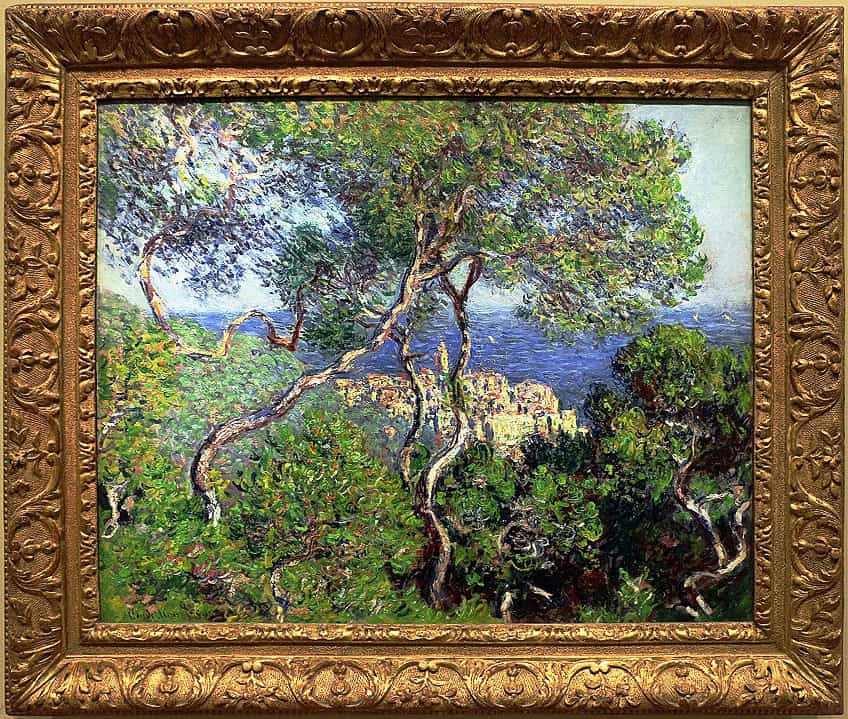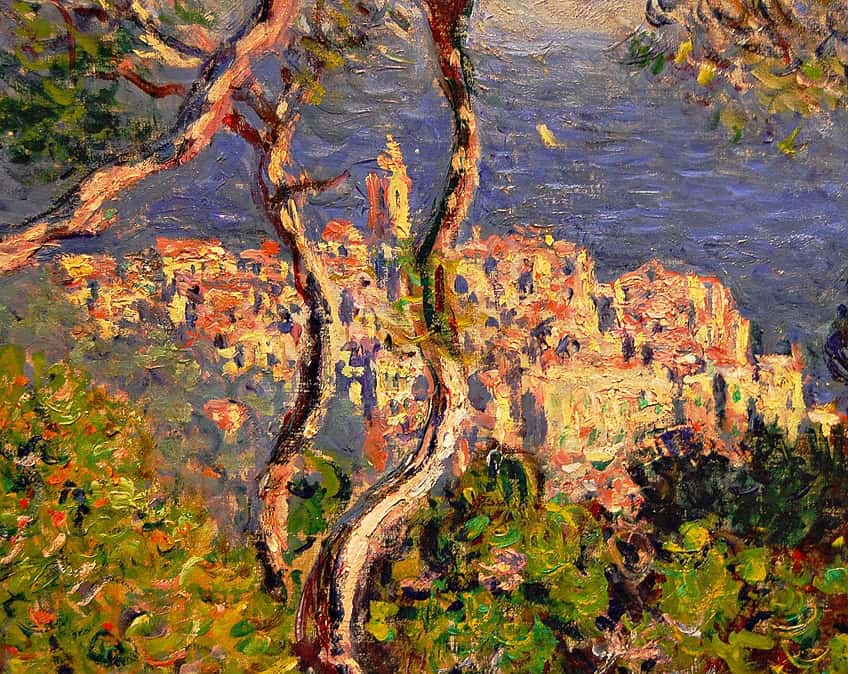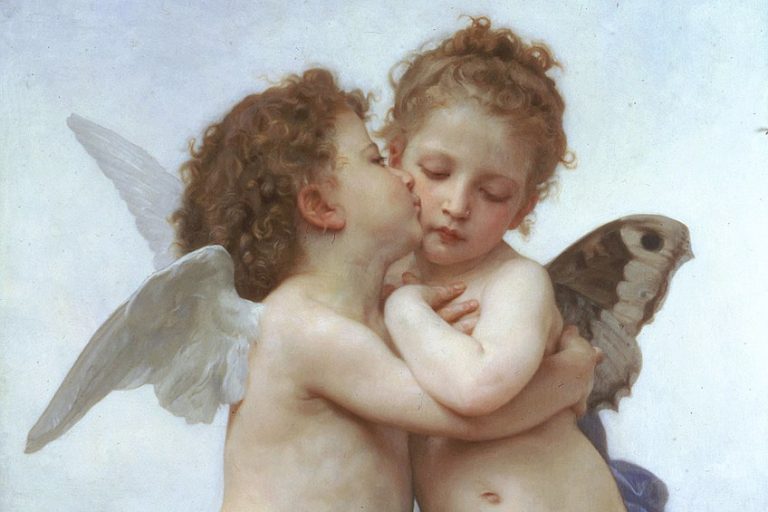“Bordighera” by Claude Monet – An Italian Coastal Dream
Bordighera, painted by Claude Monet in 1884, is a stunning example of the artist’s masterful use of color and light to capture the vibrancy of the Mediterranean landscape. During his visit to the Italian Riviera, Monet was captivated by the picturesque town of Bordighera, with its lush vegetation and striking coastal scenery. This painting exemplifies Monet’s impressionistic style, characterized by loose brushwork and an emphasis on the atmospheric effects of natural light. Bordighera reflects Monet’s fascination with the interplay of sunlight and shadow, as well as his dedication to painting en plein air, allowing viewers to experience the serene beauty and vivid colors of the Mediterranean as he did. This work not only highlights Monet’s innovative approach to landscape painting but also marks a significant period in his artistic journey, where his travels profoundly influenced his creative expression.
Table of Contents
Key Takeaways
- Monet painted Bordighera during an extended stay in the Italian Riviera.
- The painting highlights Monet’s skill in capturing Mediterranean light and scenery.
- Bordighera demonstrates the influence of travel on Monet’s artistic growth.
The Life of Claude Monet
| Artist | Claude Monet (1840 – 1926) |
| Date Created | 1884 |
| Medium | Oil on canvas |
| Genre | Landscape |
| Period/Movement | Impressionism |
| Dimensions (cm) | 65 × 80.8 |
| Series/Versions | Single version |
| Where Is It Housed? | Art Institute of Chicago, Illinois, United States |
| What It Is Worth | Not publicly auctioned; high historical and artistic value |
Claude Monet’s 1884 painting, Bordighera, is a striking example of his attempt to capture the vibrant Mediterranean light that fascinated him. Monet traveled to Bordighera, a picturesque town on the Italian Riviera, intending to stay for three weeks but ended up extending his visit to nearly three months. This prolonged stay allowed him to fully immerse himself in the landscape, resulting in a series of works that showcase his ability to translate the stunning scenery into his unique style. The painting reflects Monet’s keen interest in the interplay of light and color, fundamental elements of his impressionistic approach.

Bordighera’s lush vegetation and dramatic coastal views provided the perfect backdrop for Monet’s artistic exploration, offering new dimensions to his existing techniques. His portrayal of this Italian town highlights his skill in capturing both the transient qualities of light and the enduring beauty of nature. Monet’s Bordighera not only enriches his oeuvre but also underscores the influence of travel on his creative development. The work remains a testament to his ability to adapt and find inspiration in diverse environments, leaving an indelible mark on the art world. It continues to draw admiration for its vivid representation of the Mediterranean landscape, reflecting Monet’s enduring legacy as a master of light and color.
Bordighera Visit and Inspirations
In early 1884, Claude Monet traveled to Bordighera, a picturesque town on the Italian Riviera near the border of Italy and France. Initially planning a brief visit, he ended up staying for nearly three months, captivated by the region’s vibrant Mediterranean light and lush scenery.
Monet sought to capture the stunning interplay of light and shadow in his paintings during this period.
His correspondence with sculptor Auguste Rodin reveals his artistic struggle and dedication to translating the brilliance he observed into his work. The visit resulted in a significant body of work that underscored his mastery of light and color.
Final Years in Giverny
Monet spent his later years in the tranquil village of Giverny, located northwest of Paris. After purchasing a property there in 1883, he meticulously designed and cultivated his gardens, which became the primary inspiration for many of his renowned works.

During this period, Monet painted some of his most iconic series, including the Water Lilies and Japanese Bridge. His dedication to capturing the changing effects of light and seasons culminated in these later works. Despite struggles with cataracts in his final years, Monet continued to paint until his death in 1926, leaving a profound legacy in the world of art.
Bordighera and Its Influence on Monet
Claude Monet’s time in Bordighera profoundly impacted his approach to capturing light, landscape, and recurring motifs in his artwork. His stay extended from an initial three-week visit to nearly three months, illustrating the deep inspiration he drew from the Mediterranean environment.
Mediterranean Landscape
Bordighera, situated on the Italian Riviera, offered Monet a vivid palette of Mediterranean colors and contrasts. The town’s rugged hills, lush vegetation, and shimmering coastline provided the perfect backdrop for his explorations in light and shadow.

The Mediterranean light, distinct in its brilliance and intensity, fascinated Monet. He sought to reproduce this luminosity through his use of vibrant hues and dynamic compositions. The unique geological and botanical elements of Bordighera, including dense clusters of pine trees, dense foliage, and rocky outcrops, featured prominently in his paintings from this period.
Monet’s Artistic Technique
During his stay in Bordighera, Monet experimented with various techniques to capture the unique qualities of the landscape. He often utilized oil on canvas to render the rich textures and colors of the Mediterranean scenery. His brushwork from this period reflects a lively, almost rhythmic quality, aimed at conveying the shimmering effects of sunlight on water and foliage.
Monet’s technique involved layering and blending colors to achieve depth and luminosity.
By adopting cropping techniques similar to those used in photography, he framed his subjects in ways that emphasized their innate beauty and complexity. This approach not only highlighted the Mediterranean landscape but also marked an evolution in his artistic method.
Recurring Motifs in Monet’s Bordighera Works
In his Bordighera series, several motifs recur throughout the artwork. Pine trees stand out as a significant element, often serving as natural frames that lead the viewer’s eye into the composition. These trees are depicted with meticulous attention to detail, reflecting Monet’s fascination with their form and structure. Another prominent motif is the interplay between light and shadow, which Monet explored through varying times of day and weather conditions.

The Mediterranean light, with its exceptional clarity and brightness, became a central theme in his Bordighera pieces. Rocks, water, and architectural elements like villas and roads further enriched his compositions, providing a sense of place and atmosphere that is both specific and evocative. By capturing these motifs in his work, Monet not only celebrated the beauty of Bordighera but also expanded his own artistic horizons, influencing his later works profoundly.
Analysis of Bordighera by Claude Monet
Bordighera by Claude Monet is a remarkable example of his ability to capture the essence of nature and light. This section explores the composition, elements, and use of color in this artwork and compares it to Monet’s other works.
Composition and Elements
In Bordighera, Monet employs a composition that highlights both the natural beauty and architectural features of the Italian Riviera. Elements of foliage and sea dominate the canvas, with the Mediterranean landscape providing a stunning backdrop. The foliage, represented with intricate detail, creates a vivid sense of depth and texture, making one feel the lush surroundings.

The positioning of architectural elements, like towers overlooking the town, adds perspective and context. This combination of nature and human-made structures is a recurring theme in Monet’s work, bringing a balanced harmony to the painting. Clear, defined brushstrokes suggest motion and life, demonstrating Monet’s mastery in capturing momentary impressions.
Use of Color and Light
Monet is renowned for his adept use of color and light, and Bordighera is no exception. Vibrant blues and greens proliferate the canvas, reflecting the rich natural scenery of Bordighera. The interplay of colors showcases the lush foliage against the sparkling sea, invoking a sense of tranquility and vibrancy. Light plays a crucial role in this painting. Monet’s attempt to capture the brilliant Mediterranean light is evident through the varied intensity and direction of light throughout the scene. The contrast between illuminated areas and shadows adds a dynamic quality, conveying the ever-changing nature of sunlight.
This technique enhances the realism and emotional impact of the painting.
Comparison to Other Works
Bordighera holds a significant place among Monet’s extensive portfolio of landscape paintings. When compared to his other Mediterranean works, such as Palm Trees at Bordighera and Valley of the Nervia, similarities in style and subject matter become apparent.

Monet’s keenness to explore unique motifs like palm trees and mountains is prominent in these works. The architectural focus present in Bordighera can also be seen in his other pieces where he frequently combines natural and built environments.
Thus, Bordighera not only stands out for its unique locale but also for its consistency with Monet’s broader artistic themes and techniques.
The Legacy of Bordighera and Its Reception
Bordighera by Claude Monet, created during his stay in Italy in 1884, stands as a significant work in his portfolio. The painting is celebrated for its dynamic representation of Mediterranean light and scenery, capturing the lush landscape with masterful brushstrokes.
Critical Reception and Public Acclaim
Claude Monet’s Bordighera earned commendation for its vivid depiction of the Italian Riviera. Critics admired its use of color and light, which enhanced the natural beauty of the Mediterranean. Art historians recognized the work as an important departure from his earlier French landscapes, reflecting his ability to adapt to new environments.

Public exhibits in Paris and London further solidified its reputation, engaging audiences with its detailed portrayal of Bordighera’s palm trees and terrain. The painting’s display at prestigious institutions confirmed its lasting impact on viewers.
Monet’s Impact on Art History
Monet’s time in Bordighera marked a pivotal moment in his career, influencing his later works. His innovative techniques in conveying the Mediterranean light and lush greenery expanded the boundaries of what Impressionist landscapes could achieve. This artistic progression was recognized by contemporaries, including Auguste Rodin, who appreciated Monet’s attempts to translate bright, southern European light onto canvas.
Bordighera contributed to Monet’s legacy as a master of light and movement, solidifying his role in shaping modern landscape painting.
Preservation and Display
Efforts to preserve Bordighera have maintained its vibrancy to this day. The painting has been meticulously cared for by institutions such as the Art Institute of Chicago and the Musée d’Orsay. Its displays in various esteemed museums ensured continued public engagement and appreciation. Special exhibitions focusing on Monet or Italian landscapes often feature Bordighera, highlighting its significance within his oeuvre. These exhibits allow new generations to experience and study the intricate details and historical context of this key piece.
Monet’s Bordighera stands as a testament to his enduring fascination with light and color, capturing the essence of the Mediterranean landscape with remarkable vibrancy and immediacy. This artwork not only reflects Monet’s mastery of the impressionist technique but also his ability to convey the atmosphere and spirit of a place. The painting’s lush depiction of the Italian Riviera serves as a vivid reminder of Monet’s innovative approach to landscape painting and his relentless pursuit of capturing the fleeting moments of nature. Bordighera continues to be celebrated for its artistic brilliance and remains a significant piece within Monet’s oeuvre, exemplifying the profound impact of his travels on his artistic vision and legacy.
Frequently Asked Questions
What Was Claude Monet’s Inspiration for Painting Bordighera?
Claude Monet traveled to Bordighera, a town on the Italian Riviera, in early 1884. Initially planning a three-week stay, he extended his visit to nearly three months. Monet was captivated by the brilliance of the Mediterranean light and the lush landscape, which he attempted to translate into his paintings.
How Does Bordighera Reflect Claude Monet’s Impressionist Style?
Bordighera showcases Monet’s impressionist techniques, including the use of light and vibrant colors. The application of quick, short brushstrokes to capture the essence of the landscape is evident. His experimentation with light and atmospheric conditions is a hallmark of his impressionist approach.
What Is the Historical Significance of the Bordighera Painting in Monet’s Career?
Bordighera marks a pivotal moment in Monet’s career, illustrating his transition into a more confident and mature phase of his artistry. This period in Bordighera allowed him to explore new techniques and refine his impressionist style further. The painting is part of a broader collection of works that cemented Monet’s reputation as a leading impressionist artist.
Isabella studied at the University of Cape Town in South Africa and graduated with a Bachelor of Arts majoring in English Literature & Language and Psychology. Throughout her undergraduate years, she took Art History as an additional subject and absolutely loved it. Building on from her art history knowledge that began in high school, art has always been a particular area of fascination for her. From learning about artworks previously unknown to her, or sharpening her existing understanding of specific works, the ability to continue learning within this interesting sphere excites her greatly.
Her focal points of interest in art history encompass profiling specific artists and art movements, as it is these areas where she is able to really dig deep into the rich narrative of the art world. Additionally, she particularly enjoys exploring the different artistic styles of the 20th century, as well as the important impact that female artists have had on the development of art history.
Learn more about Isabella Meyer and the Art in Context Team.
Cite this Article
Isabella, Meyer, ““Bordighera” by Claude Monet – An Italian Coastal Dream.” Art in Context. June 13, 2024. URL: https://artincontext.org/bordighera-by-claude-monet/
Meyer, I. (2024, 13 June). “Bordighera” by Claude Monet – An Italian Coastal Dream. Art in Context. https://artincontext.org/bordighera-by-claude-monet/
Meyer, Isabella. ““Bordighera” by Claude Monet – An Italian Coastal Dream.” Art in Context, June 13, 2024. https://artincontext.org/bordighera-by-claude-monet/.











